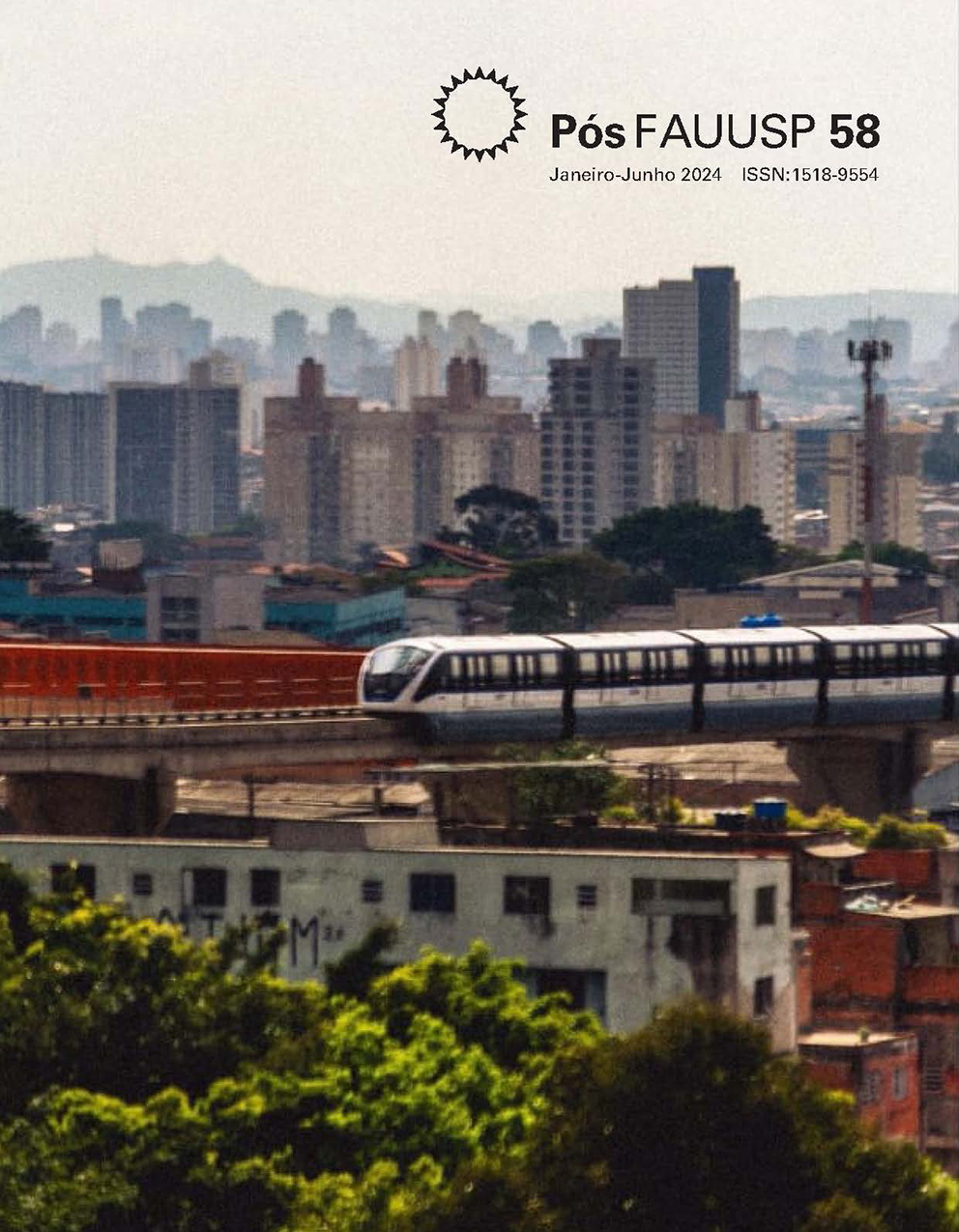Brutally modern walls: the supremacy of the hybrid building in São Paulo’s architecture in the 1960s
DOI:
https://doi.org/10.11606/issn.2317-2762.posfauusp.2024.207275Keywords:
Structural wall, Independent structure, São Paulo Brutalist SchoolAbstract
The view of an architecture of punctual supports, like the Parthenon, historically captures architects' desire regarding the construction with the structural wall. In the Renaissance, beyond the freestanding columns, the skeleton is represented amid the surfaces: Brunelleschi at Pazzi Chapel; Alberti at Palazzo Rucellai. At the end of the nineteenth century, the structural framework was made concrete: the independent structure with its punctual supports made continuous constructive systems of structural walls obsolete. In its assimilation, Le Corbusier promotes a specific independent structure, proposed in the Dom-Ino house, with free disposition of walls without visible beams. In Brazil, Lucio Costa understands the Dom-Ino- ype skeleton by the characteristic and preferential structure of modern architecture, which connects to special structures and walls for hybrid alternatives. In this sense, works of São Paulo Brutalism evidence the coexistence of punctual and continuous supports. This article discusses the radical transformations in this architecture not by its materiality but as a rupture of this hierarchic system. The wall, until then attributed as a pure cladding element, is a fundamental agent of systemic mutation, with hybrid, formal, and constructive perception. The investigation reveals the importance of hybrid solutions under the tensions between structural behavior and formal demands.
Downloads
References
APARICIO, Jesús Maria. El muro, concepto esencial en el proyecto arquitetónico: la materialización de la idea y la idealización de la materia. Madrid: Cp67, 2000.
BAHIMA, Carlos Fernando Silva. De placa e grelha: transformações dominoicas em terra brasileira. 2015. Tese (Doutorado em Arquitetura) – Universidade Federal do Rio Grande do Sul, Porto Alegre, 2015.
BAHIMA, Carlos Fernando Silva. Estrutura independente e parede portante: origem e evolução da proposição de Lucio Costa. In: ENCONTRO DA ASSOCIAÇÃO NACIONAL DE PESQUISA E PÓS-GRADUAÇÃO EM ARQUITETURA E URBANISMO, 4., 25-29 jul. 2016, Porto Alegre. Anais […]. [S. l.]: Anparq, 2016.
BRUAND, Yves. Arquitetura contemporânea no Brasil. São Paulo: Perspectiva, 1981.
CARTER, Peter. Mies van der Rohe at Work. London: Phaidon, 2001.
CHING, Francis D. K. Sistemas estruturais ilustrados, padrões, sistemas e projeto. Porto Alegre, Bookman, 2010. COMAS, Carlos Eduardo Dias. Arquitetura moderna estilo Corbu, Pavilhão brasileiro. Arquitetura e Urbanismo, São Paulo, n. 26, out./nov. 1989.
COMAS, Carlos Eduardo Dias. Précisions brésiliennes sur un état passé de l’architecture et de l’urbanisme modernes d’après les projets de Lucio Costa, Oscar Niemeyer, MMM Roberto, Affonso Reidy, Jorge Moreira et cie., 1936-45. 2002. Tese (Doutorado) – Université de Paris VIII, Paris, 2002. Tradução: Precisões Arquitetura Moderna Brasileira 1936-45. Porto Alegre: PROPAR, 2002.
COMAS, Carlos Eduardo Dias. The Poetics of Development: Notes on Two Brazilian Schools. In: BERGDOLL, Barry; COMAS, Carlos Eduardo; LIERNUR, Pos FAUUSP 13 Pos FAUUSP, São Paulo, v. 31, n. 58, e207204, jan-jun 2024.
QUETGLAS, Josep. Les Heures Claires: proyecto y arquitectura en la Villa Savoye de Le Corbusier y Pierre Jeanneret. Sant Cugat del Vallès: Massilia, 2009.
ROBERTSON, Donald Straun. Arquitetura grega e romana. São Paulo: WMF Martins Fontes, 2014.
ROWE, Colin. The Mathematics of the Ideal Villa and Other Essays. Cambridge: The MIT Press, 1976.
SUMMERSON, John. A linguagem clássica da arquitetura. São Paulo: Martins Fontes, 1999.
TORROJA, Eduardo. Razón y ser de los tipos estructurales. Madrid: Instituto Eduardo Torroja de la construcción y del cemento, 1960.
VASCONCELOS, Augusto Carlos de. Estruturas arquitetônicas: apreciação intuitiva das formas estruturais. São Paulo: Studio Nobel, 1991.
VITRÚVIO. Tratado de arquitetura. São Paulo, Martins Fontes, 2007. (Todas as Artes).
WITTKOWER, Rudolf. Architectural Principles in the Age of Humanism. New York: Norton and Company, 1971.
WÖLFFLIN, Heinrich. Renascença e barroco: estudo sobre a essência do estilo barroco e sua origem na Itália. São Paulo: Perspectiva, 2005.
ZEIN, Ruth Verde. A arquitetura da Escola Paulista Brutalista: 1953-1973. 2005. Tese (Doutorado em Arquitetura) – Universidade Federal do Rio Grande do Sul, Porto Alegre, 2005.
Downloads
Published
Issue
Section
License
Copyright (c) 2024 Carlos Fernando Bahima

This work is licensed under a Creative Commons Attribution-NoDerivatives 4.0 International License.

This work is licensed under a Creative Commons Attribution 4.0 International License.
DIADORIM - Diretório de Políticas Editoriais












